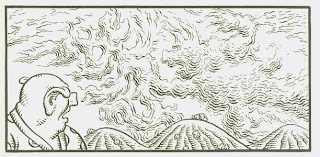 " How to Read Weathercraft; or, How I Read It and What I Learned."
" How to Read Weathercraft; or, How I Read It and What I Learned."
1. Read only the interior pages, the story proper. Do not read the material on the book jacket, which gives information about the characters, their world, and the story. Do not think about the significance of the title, and do not look closely at the cover. 2. After a first reading, then read all of the material on the jacket: realize how much you missed, how much you could have understood if you had read with greater care. Realize, also, that if you had thought about the title (and/or the cover image), many scenes that mystified you would have been clear. Acknowledge that you are an inattentive, and at times even a sloppy reader; but don’t get down on yourself. It was great to begin with, and will be even better the second time.
2. After a first reading, then read all of the material on the jacket: realize how much you missed, how much you could have understood if you had read with greater care. Realize, also, that if you had thought about the title (and/or the cover image), many scenes that mystified you would have been clear. Acknowledge that you are an inattentive, and at times even a sloppy reader; but don’t get down on yourself. It was great to begin with, and will be even better the second time. 3. Read it again; during the second reading, achieve a new, but still incomplete sense of clarity, much like MH himself. Realize that a good comic changes each time you read it; ponder the implications this has for any theory of comics; such theories typically do not have a good sense of the roles played by different types of readers in creating meaning, nor do they recognize what happens to things like closure on the 2nd, 3rd, or 4th reading.
3. Read it again; during the second reading, achieve a new, but still incomplete sense of clarity, much like MH himself. Realize that a good comic changes each time you read it; ponder the implications this has for any theory of comics; such theories typically do not have a good sense of the roles played by different types of readers in creating meaning, nor do they recognize what happens to things like closure on the 2nd, 3rd, or 4th reading. 4. Watch the video at the Flog, in which cartoonist Jim Woodring works his way through the book. Again, realize that many of the things he talks about are clearly presented, but that you didn’t pick up on what was being laid down. Also, understand that some of the imagery is highly personal to Woodring, and so what it means to him and him and how it works in the story, is inaccessible to you, though on the book jacket he promises to explain some of it if you ask him in person. Plan to do so.
4. Watch the video at the Flog, in which cartoonist Jim Woodring works his way through the book. Again, realize that many of the things he talks about are clearly presented, but that you didn’t pick up on what was being laid down. Also, understand that some of the imagery is highly personal to Woodring, and so what it means to him and him and how it works in the story, is inaccessible to you, though on the book jacket he promises to explain some of it if you ask him in person. Plan to do so. 5. Read it a third time, thinking about Woodring’s video commentary, and recognize how cohesive it is. There’s a real clarity to the plot and to Woodring’s character designs and panel compositions. You will think that, in some way, the key to much of this is the artist's omnipresent wavy line, but will be unsure.
5. Read it a third time, thinking about Woodring’s video commentary, and recognize how cohesive it is. There’s a real clarity to the plot and to Woodring’s character designs and panel compositions. You will think that, in some way, the key to much of this is the artist's omnipresent wavy line, but will be unsure. Plan to return to Weathercraft soon.
Plan to return to Weathercraft soon.
Friday, June 18, 2010
Weathercraft
Subscribe to:
Post Comments (Atom)


4 comments:
If I remember correctly, Jim noted at his tour stop in Berkeley that the wavy lines are a sort of manifestation of the consciousness of the Unifactor. Or something like that.
Anyway, what a helluva book.
Paul,
I like that idea about the wavy lines -- makes sense. And you are right: it's a great book -- and it deserves much more press.
Please read Paul on the book here:
http://www.espabl.com/comics/jim-woodring-weathercraft/
My copy came in today.
Post a Comment